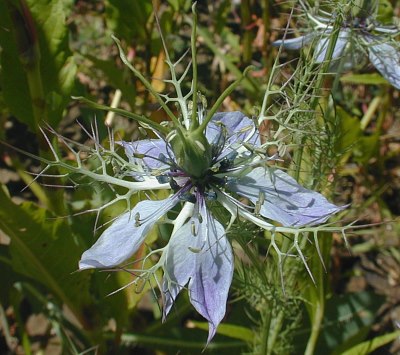Herbs , annual, from taproots. Leaves basal and cauline, petiolate or distal leaves sessile; cauline leaves alternate. Leaf blade 2-3-pinnately dissected, segments linear, threadlike [ovate or oblong or sometimes undivided, short], margins entire. Inflorescences terminal or axillary, flowers solitary; involucres present [absent], involucral bracts 5-6, finely pinnately dissected, closely subtending flower. Flowers bisexual, radially symmetric; sepals persistent in fruit, 5-25, blue to white or pink [yellowish white or green], plane, ovate, clawed [not clawed], 8-25 mm, apex acuminate; petals (0-)5-10, distinct, lead-colored, hooded, obovate, 2-labiate, 2-5 mm; nectary apical; stamens 15-75; filaments filiform; staminodes absent between stamens and pistils; pistil compound [carpels connate proximally], [2-]5-10-carpellate; ovules 25-100; style present. Fruits capsular [partially connate follicles], sessile, inflated-spheric [not inflated], sides not prominently veined; beak terminal, straight, 13-20 mm. Seeds black, broadly obovate, reticulate, with raised ridges. x =6.
Sep 5, petaloid; pet none; staminodes 5 or more; short, clawed, distally 2-lobed; stamens many; pistils 5-10, connate to about the middle, prolonged above into subulate styles; fr of connate, beaked follicles; annuals with finely dissected lvs and large, regular, terminal fls. 15+, Medit. region and w. Asia.
Gleason, Henry A. & Cronquist, Arthur J. 1991. Manual of vascular plants of northeastern United States and adjacent Canada. lxxv + 910 pp.
©The New York Botanical Garden. All rights reserved. Used by permission.




